A change in strategy rather than more efficient technology will lead to hiring stronger people.
Whenever asked about the latest hiring buzz I always respond by saying that while the buzz is louder than ever, when it comes to hiring stronger people very little has changed. That’s why everyone still considers hiring strong talent an ongoing challenge.
The reason for lack of progress is that there’s too much focus on being more efficient rather than improving quality of hire. Being more efficient using job boards to find stronger talent is unlikely when the strongest people either aren’t looking or not applying.
The solution requires a change in strategy not more efficient technology. Simply stated:
No matter how efficient, a surplus of talent strategy won’t work when a surplus of talent doesn’t exist.
This concept is demonstrated in the graphic. The surplus strategy at the top moves left to right and is designed to weed out the weak. The scarcity strategy moves at the bottom, moves right to left and is designed to attract the best.
The surplus model is based on the idea that there are enough few talented people who will respond to boring job descriptions that are at best are ill-defined lateral transfers (the HAVE criteria) as long as you surround them with generic boilerplate and hyperbole. To determine if it’s worth interviewing these few “qualified” people they’re then screened on what they GET on the start date—a salary, company, title and location.
Companies somehow fail to recognise that neither the HAVE nor GET criteria predict a person’s on-the-job performance. Worse, it excludes the best people who have the skillset but won’t apply to what appears to be an ill-defined lateral transfer. The process also excludes all diverse and high potential candidates who could do the work but who have a different mix of skills and experience than listed on the traditional job description.
Reversing the process starts by defining the job as a series of 5-6 KPOs (key performance objectives) to replace the laundry list of “Must Haves.” Assessing competency involves having candidates describe their most comparable accomplishments for each of the KPOs. If proven to be competent it’s obvious the person has all the skills, experiences and credentials needed but likely a different mix than what was on the original job description. Attracting these people is possible as long as what the person could BECOME if successful represents a true career move.
Technology can certainly be built to handle this scarcity model, but progress has been slow for a variety of reasons. Lack of understanding for one. Stiff resistance to shift to a performance-qualified approach for defining work is another. Compliance and legal reasons add to the list of excuses. But perhaps most important of all is that tech vendors have no need to invest in these changes when there’s less risk and more growth opportunity selling an old-fashioned job posting process that’s more efficient.
Despite a full technical solution, the scarcity model is the default choice when companies want to fill critical roles. In these cases success always requires a great job that represents a clear career move, a committed hiring manager and a strong recruiter.


